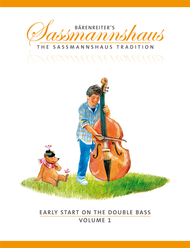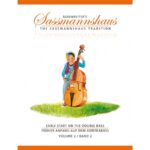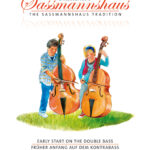Description
Early Start on the Double Bass encompasses everything that one would expect from a Sassmannshaus method: an easy start, progression at a suitable rate, many cross-references to the other string instruments, songs and scales in different positions from early on, as well as many duets. Lively and colourful illustrations by Charlotte Panowsky complete the edition.
After the first pages featuring open strings and basic note values, the “cuckoo call” is introduced as a basic interval. Note reading is practiced from the beginning, and accidentals are explained in an easily understandable way. By the end of the first book, students have had the opportunity to play many English children’s songs using the first, second and fourth fingers, and note values from whole to eighth notes have been learned. Most exercises are underlaid with text so that rhythms can be easily learned and melodies can be perceived as a whole. The important melodic building blocks of thirds, triads and scales are introduced. Scales in C, G, F, and B-flat major are played in one octave.
About Baerenreiter’s Sassmannshaus
Children playfully learn reliable technique at the earliest age. For more than three decades the Sassmannshaus Tradition has been the household name for excellence in beginner methods in German-speaking countries. More than half a million students have successfully learned to play using this publication.
This tried and tested German method is now available in English! The best-selling method that gave generations of European musicians their foundation is now available in English, with content and songs newly adapted for today’s English speaking children.
What makes this method so special?
- The child-friendly and age-appropriate text underlying the music enables children to perceive melodies as a whole and to understand their singable qualities.
- Songs and scales in different positions are easily explained and mastered within the first year. This is an important advantage over methods that confine children to the first position for many years.
- Note reading is emphasized from the first lesson – children are brought up to become proficient sight-readers and play in chamber music ensembles as early as possible.
- In contrast to other beginner methods, The Sassmannshaus Tradition progresses swiftly by introducing advanced techniques in rudimentary form, such as shifting and varied bow strokes.
- Ensemble playing is encouraged from the very beginning.
- The method is suitable for single instruction as well as for group and class lessons.
- The large print notes and text as well as many colorful illustrations are particularly child-friendly and very attractive to pre-school children and school children alike.
- The substantial volumes contain comprehensive material and carefully calibrated learning curves. They keep children curious and interested for many months and years.




